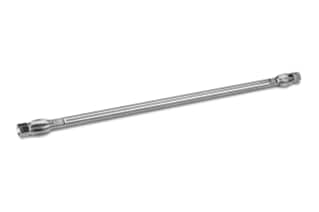
|
Chemistry |
Amide |
|
Separation Mode |
Hydrophilic Interaction (HILIC) |
|
Particle Substrate |
Hybrid |
|
pH Range Min |
2 pH |
|
pH Range Max |
11 pH |
|
Maximum Pressure |
6000 psi (415 Bar) |
|
Endcapped |
No |
|
Silanol Activity |
Low |
|
Particle Shape |
Spherical |
|
Particle Size |
5 µm |
|
Endfitting Type |
Waters |
|
Pore Size |
130 Å |
|
Format |
Column |
|
Surface Area |
185 |
|
System |
HPLC |
|
Particle Technology |
BEH |
|
USP Classification |
L68 |
|
Inner Diameter |
4.6 mm |
|
Length |
250 mm |
|
Carbon Load |
12 % |
|
UNSPSC |
41115709 |
|
Brand |
XBridge |
|
Product Type |
Columns |
|
Units per Package |
1 pk |
XBridge BEH Amide Column, 130Å, 5 µm, 4.6 mm X 250 mm, 1/pk
Since 2003, Waters has been committed to the development of innovative stationary phases for Hydrophilic Interaction Chromatography (HILIC) as a way to overcome the challenge of retaining and separating extremely polar compounds. Based on the novel ethylene bridged hybrid (BEH) particle technology, XBridge BEH Amide Columns make use of a chemically stable, trifunctionally bonded amide phase that enables a new dimension of stability and versatility for HILIC separations. With the same selectivity as ACQUITY UPLC BEH Amide columns, scientists can transfer separations between HPLC and UPLC technology platforms seamlessly.
XBridge BEH Amide Columns are designed to retain polar analytes and metabolites that are too polar to retain with reversed-phase chromatography and facilitate the use of a wide range of mobile phase. This facilitates exceptional retention of polar analytes that span a wide range in polarity, structural moiety, and pKa. In addition to this enhanced retention, XBridge BEH Amide Columns offer increased mass spectrometry response, direct compatibility with sample preparation elutates, as well as orthogonal selectivity compared to reversed-phase materials.
One of the most common classes of compounds analyzed by HILIC are carbohydrates, and XBridge BEH Amide Columns are a piece of lab equipment designed for this task. The increased chemical stability enables the use of high pH and high temperature to collapse anomers without the loss of reducing sugars and prevent Schiff base formations, improving quantitation accuracy.
XBridge BEH Amide Columns are created using strict manufacturing processes that guarantee reproducibility, and testing can be performed using HILIC QC Reference Material from Waters.
What Injection Solvents Should I Use With XBridge BEH Amide Columns?
If possible, any injection solvents used should be as close to the mobile phase composition as possible (if isocratic) or the starting gradient conditions. A generic injection solvent is 75:25 acetonitrile:methanol, which is a good compromise between analyte solubility and peak shape. When separating saccharides with limited solubility in organic solvents, higher concentrations of aqueous solvent in the sample are acceptable. 50:50 acetonitrile:water can offer satisfactory results. Injection solvent’s influence on peak shape should be determined in an experimental manner. In some cases, injections of water may not have an adverse impact on peak shape.